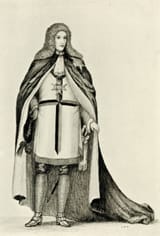Search Results
7/9/2025, 7:39:05 AM
>>509896884
>Despite opposition from within the Catholic Church and government circles, freemasonry achieved traction within the French aristocracy and among the wealthy to the extent that in September 1737 the Daily Advertiser could report from its correspondent in Paris that
>"The Order of Freemasons lately established here meets with great success; everyone is desirous of being admitted a member, and numbers are daily taken in at the expence [sic] of ten Louis d’Ors each… There are nineteen lodges already constituted’. Indeed, according to the press, so successful was freemasonry that ‘the ladies are about to establish a counter order in imitation."
>Where French freemasonry differed from its Anglo-Saxon counterpart was in its embrace of a more complex, theatrical, and quasi-spiritual chivalric ritual. This found adherents among the aristocracy and Court circles elsewhere in Europe, including the German states, Austria and Sweden, where it would later be transformed by Charles XIII into the Swedish Rite
>The launch point for chivalric freemasonry is frequently identified, rightly or wrongly, with the oration given at Derwentwater’s Paris lodge in December 1736 by Andrew Michael Ramsay: ‘Chevalier Ramsay’. Ramsay inflated the Craft’s lineage, tracing it back to Abraham, the Jewish patriarchs and ancient Egypt. He placed freemasonry within a medieval context, dating the origin of modern freemasonry to the Crusades when ‘many princes, lords and citizens associated themselves and vowed to restore the Temple of the Christians in the Holy Land, to employ themselves in bringing back their architecture to its first institution’
>Despite opposition from within the Catholic Church and government circles, freemasonry achieved traction within the French aristocracy and among the wealthy to the extent that in September 1737 the Daily Advertiser could report from its correspondent in Paris that
>"The Order of Freemasons lately established here meets with great success; everyone is desirous of being admitted a member, and numbers are daily taken in at the expence [sic] of ten Louis d’Ors each… There are nineteen lodges already constituted’. Indeed, according to the press, so successful was freemasonry that ‘the ladies are about to establish a counter order in imitation."
>Where French freemasonry differed from its Anglo-Saxon counterpart was in its embrace of a more complex, theatrical, and quasi-spiritual chivalric ritual. This found adherents among the aristocracy and Court circles elsewhere in Europe, including the German states, Austria and Sweden, where it would later be transformed by Charles XIII into the Swedish Rite
>The launch point for chivalric freemasonry is frequently identified, rightly or wrongly, with the oration given at Derwentwater’s Paris lodge in December 1736 by Andrew Michael Ramsay: ‘Chevalier Ramsay’. Ramsay inflated the Craft’s lineage, tracing it back to Abraham, the Jewish patriarchs and ancient Egypt. He placed freemasonry within a medieval context, dating the origin of modern freemasonry to the Crusades when ‘many princes, lords and citizens associated themselves and vowed to restore the Temple of the Christians in the Holy Land, to employ themselves in bringing back their architecture to its first institution’
Page 1
